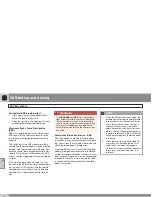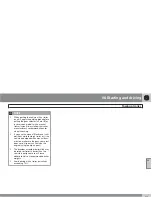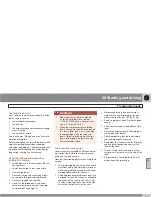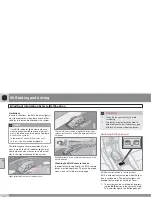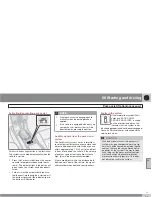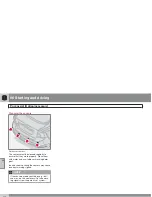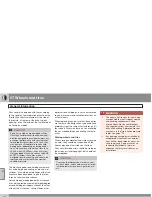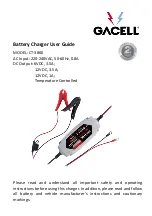
06 Starting and driving
Blind Spot Information System (BLIS)–option
06
``
165
When does BLIS function
The system functions when your vehicle is
moving at speeds above 6 mph (10 km/h).
When you pass another vehicle:
The system reacts when you pass another
vehicle at a speed of up to 6 mph (10 km/h)
faster than that vehicle.
When you are passed by another vehicle:
The system reacts if your vehicle is passed by
another vehicle at a speed of up to 43 mph
(70 km/h) faster than your vehicle.
WARNING
•
BLIS does not function in sharp curves.
•
BLIS does not function when your vehi-
cle is backing up.
•
If you are towing a wide trailer, this may
prevent the BLIS cameras from detect-
ing other vehicles in adjacent lanes.
How BLIS functions in daylight and
darkness
Daylight
BLIS reacts to the
shape
of surrounding vehi-
cles. The system is designed to help detect
motor vehicles such as cars, trucks, buses,
motorcycles, etc.
Darkness
BLIS reacts to the
headlights
of surrounding
vehicles. In order to be detected by BLIS, a
vehicle in the blind area must have its head-
lights on. This means, for example, that the
system will not detect a trailer without head-
lights that is being towed behind a car or truck.
WARNING
•
BLIS does not react to cyclists or
mopeds.
•
BLIS does not react to vehicles that are
standing still.
•
The function of the BLIS cameras may
be affected by intense light, or when
driving at night in areas where there are
no external sources of light (e.g., street
lights, other vehicles, etc.). In such
cases, the system may react as if the
cameras were obscured.
•
In both of the above mentioned condi-
tions, a message will appear in the infor-
mation display.
•
When driving in such conditions, the
system's function will be limited or it
may be temporarily switched off, see
page 166 for instructions.
•
When the message is no longer dis-
played, BLIS will return to normal func-
tion.
•
The BLIS cameras have the same limi-
tation as the human eye. In other words,
their "vision is impaired" by adverse
weather conditions such as heavy
snowfall, dense fog, etc.
Summary of Contents for 2009 S40
Page 1: ...VOLVO S40 Owner s manual Web Edition...
Page 2: ......
Page 8: ...Contents 12 12 Index Index 276...
Page 9: ...Contents...
Page 15: ...01 SAFETY...
Page 47: ...01 Safety 01...
Page 49: ...02 INSTRUMENTS AND CONTROLS...
Page 50: ...02 Instruments and controls Instrument overview 02 G019488...
Page 89: ...02 Instruments and controls 02...
Page 91: ...03 CLIMATE...
Page 102: ...G020908 Front seats 104 Interior lighting 107 Storage compartments 109 Rear seat 113 Trunk 115...
Page 103: ...04 INTERIOR...
Page 109: ...04 Interior Storage compartments 04 G026508...
Page 117: ...05 LOCKS AND ALARM...
Page 133: ...05 Locks and alarm 05...
Page 135: ...06 STARTING AND DRIVING...
Page 171: ...06 Starting and driving 06...
Page 173: ...07 WHEELS AND TIRES...
Page 199: ...07 Wheels and tires 07...
Page 200: ...G020920 Washing and cleaning the car 202 Paint touch up 206...
Page 201: ...08 CAR CARE...
Page 207: ...08 Car care 08...
Page 209: ...09 MAINTENANCE AND SERVICING...
Page 237: ...09 Maintenance and servicing 09...
Page 239: ...10 AUDIO...
Page 259: ...10 Audio 10...
Page 261: ...11 SPECIFICATIONS...
Page 262: ...11 Specifications Label information 11 G032544 G026483...
Page 284: ...12 Index 12...
Page 285: ......
Page 286: ...Kdakd 8Vg 8dgedgVi dc IE JH6 8VcVYV 6I Eg ciZY c HlZYZc iZWdg 8deng i Kdakd 8Vg 8dgedgVi dc...




